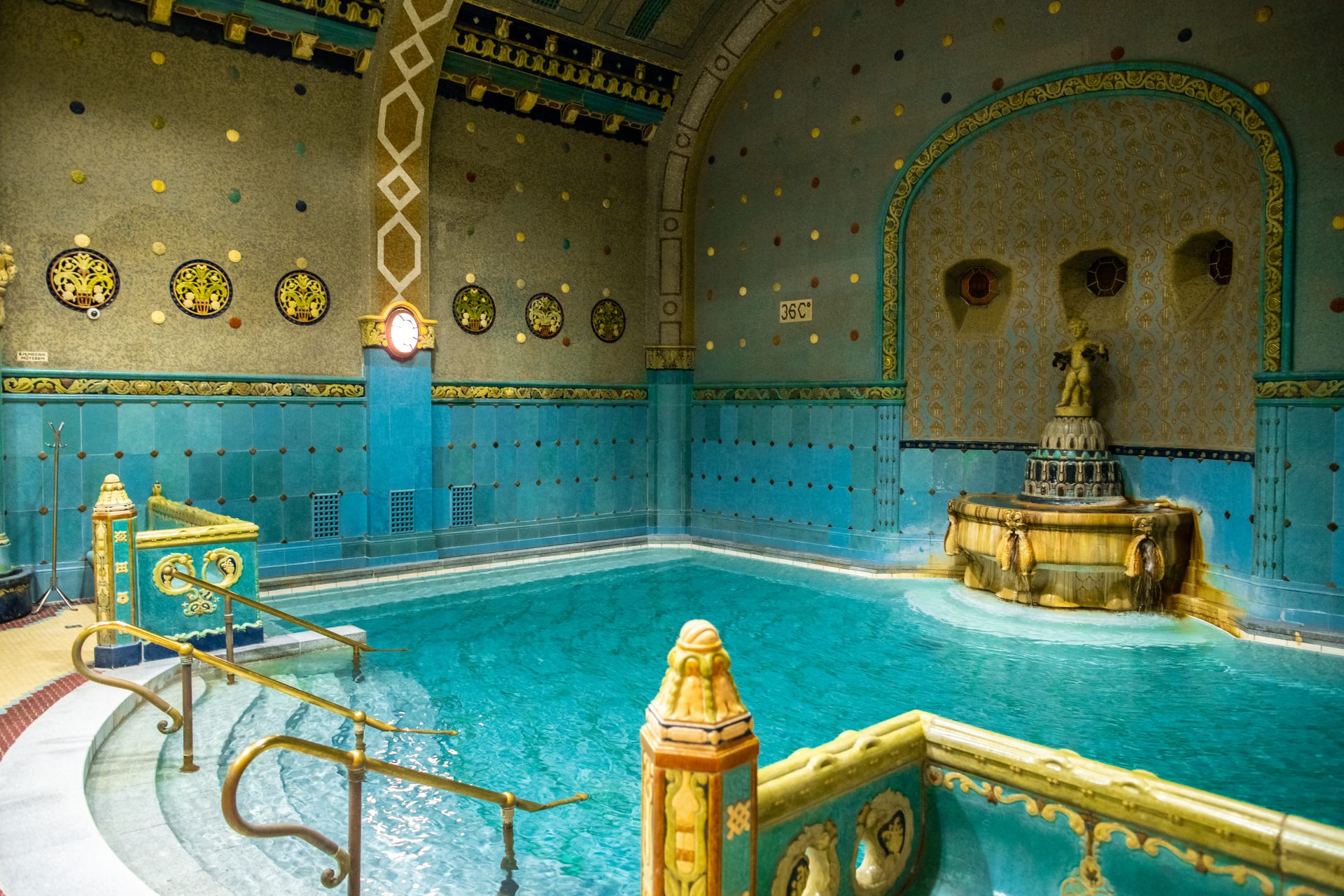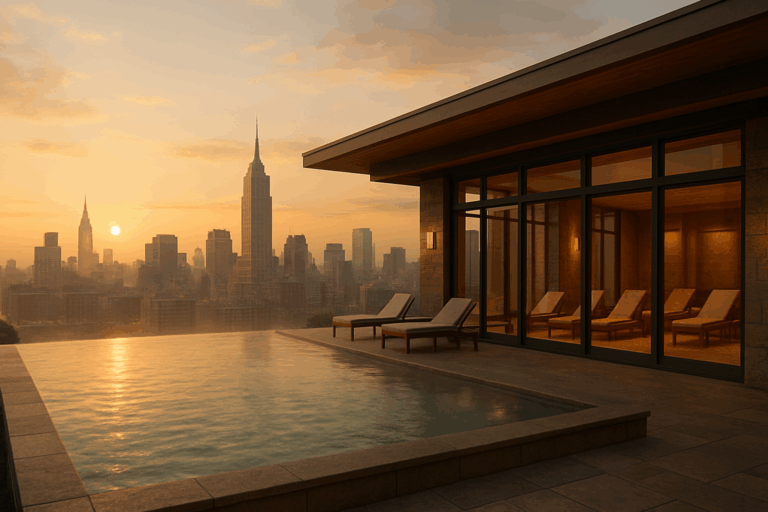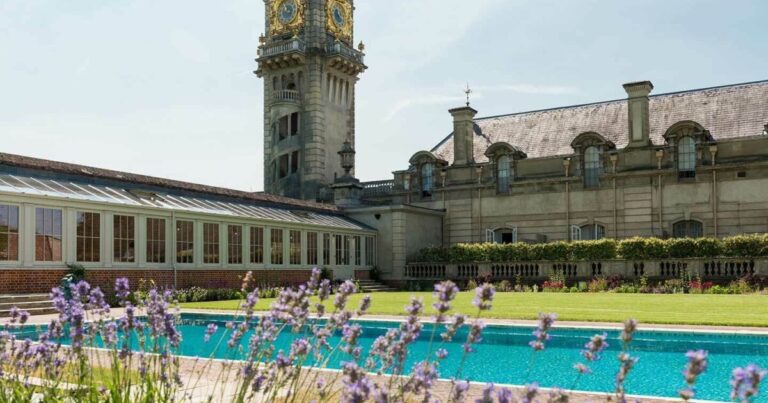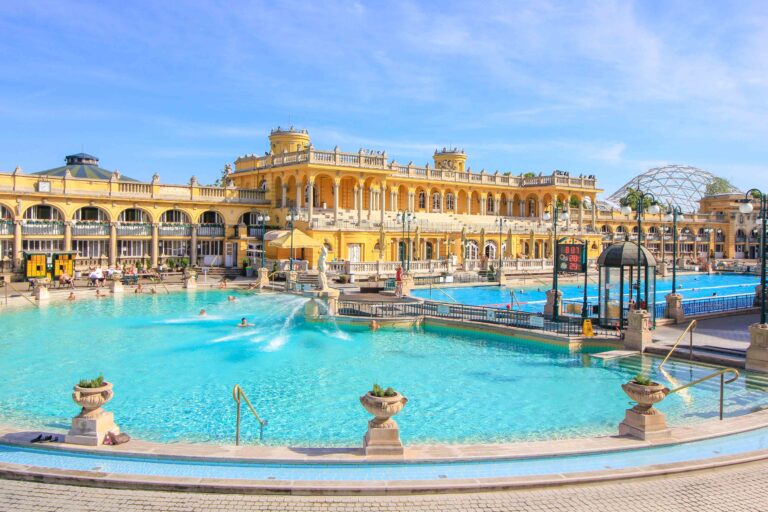Art‑Nouveau Grandeur Meets Medicinal Waters in Buda.
The Gellért Thermal Bath is a central character in Budapest’s spa narrative. Built between 1912 and 1918 as part of the historic Hotel Gellért, the bath sits at the foot of Gellért Hill, drawing therapeutic water from springs recorded since the 13th century.
Its Art Nouveau hall, tiled in Zsolnay ceramics, crowned with stained‑glass skylights and columns worthy of a cathedral, speaks to the capital’s Secessionist flourish.
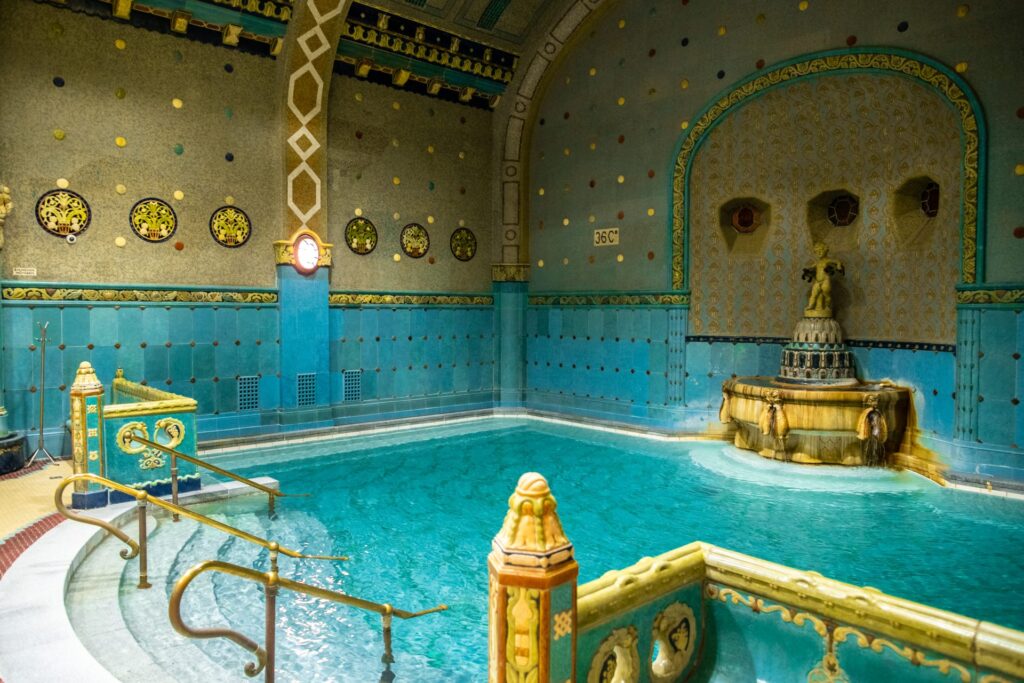
Yet this is not an Instagram prop but a working “medicinal bath” that still prescribes its pools to treat joint disorders and circulation issues.For travellers used to wellness tourism’s polished veneers, Gellért’s honesty is refreshing.
The 10‑plus pools range from a cool 27 °C swimming pool to medical baths heated to 38 °C and an outdoor wave pool that debuted one of the world’s first wave machines in 1927. Its thermal water is rich in calcium, magnesium, hydrogen‑carbonate and other minerals, giving it a faintly metallic scent that is part of the experience.
This is a bathhouse that honours Budapest’s bathing heritage while navigating 21st‑century crowds. Below is an editorially balanced look at why Gellért remains a pilgrimage for architecture lovers and wellness seekers, and what to know before you go.
Architecture, Design & Ethos
Gellért Bath is often described as a secular cathedral. The Secession‑style building was designed by Ármin Hegedűs, Artúr Sebestyén and Izidor Sterk and completed in 1918.
Inside, mosaics, stained glass and gilt railings frame a 246 m² indoor pool and four therapeutic pools ranging from 35 °C to 40 °C. Pink marble columns support a glass roof, while Zsolnay ceramic tiles and pyrogranite ornaments give a delicate sheen to the bath halls.
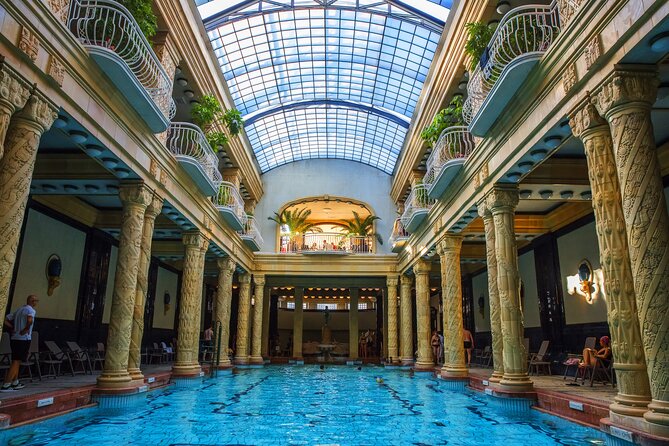
Even the foyers and shower rooms are decorated, prompting travel writers to spend more time photographing ceilings than bathing. Outside, a 500 m² wave pool and a smaller warm sitting pool allow bathers to enjoy Gellért’s healing water in sunlight.
The ethos remains grounded in medicinal bathing. The mineral content of the water – calcium, magnesium, bicarbonate, alkalis, chloride, sulphate and fluoride – is believed to relieve degenerative joint disorders, spinal conditions and circulatory problems.
Treatment pools include traction pools for spinal therapy, plunge pools and effervescent baths. The addition of a wave pool in 1927 and a glass‑domed thermal hall in 1934 highlights how the baths have blended modernity with tradition.
Treatments & Unique Offerings
Gellért has 13 pools of varying temperatures. The main indoor pool (27 °C) requires a swim cap for lap swimming, while two outdoor pools – a wave pool and a warm 36 °C pool – operate from May to September.
The thermal pools inside (35–40 °C) are prescribed for joint and muscle issues, and two plunge pools (cold and warm) aid circulation.
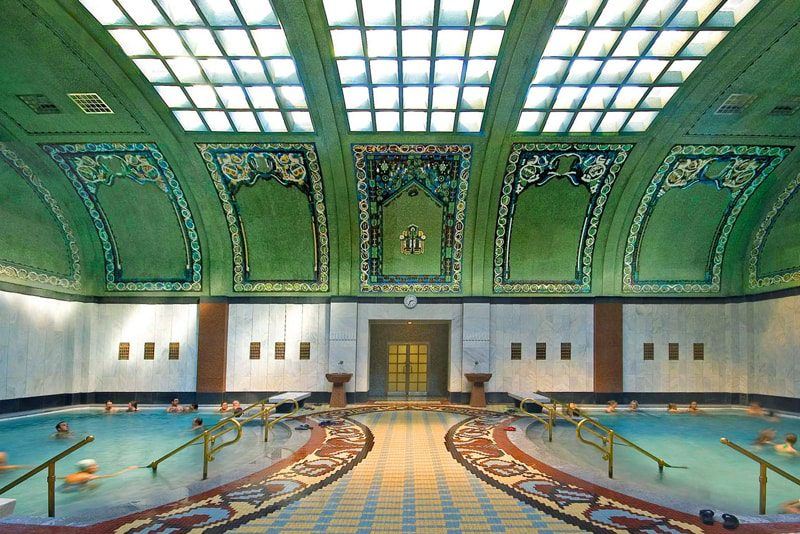
Massage and spa treatments are more limited than at newer luxury spas but offer authenticity. The official price list shows 20‑minute aroma or refreshing massages from 10 800 Ft (approx. £24) and longer “harmony” treatments combining thermal bathing and massage.
Ulysses’ travel guide notes pedicures, wine therapy and even chocolate treatments. Seasonal massages at the spa incorporate ginger, lime and other ingredients.
While mud treatments were discontinued recently, Gellért still offers unique traction therapy pools for spine decompression.
Ideal Traveller Types
Architecture & history buffs: Those interested in Secessionist architecture will appreciate the mosaics, stained glass and original 1918 fittings. The baths double as a living museum.
Couples & solo wellness seekers: Reviewers often mention the soothing atmosphere and the ability to find quieter corners, making it ideal for couples or individuals seeking calm.
However, families with small children should note that the thermal pools are generally for adults; the official rules state children under 14 may only enter with a doctor’s prescription.
Medical visitors: Locals still visit for prescribed treatments like underwater traction and physiotherapy; travellers with chronic joint issues may benefit from the mineral‑rich waters.
Stand‑Out Differentiators
Gellért is distinguished by its Art Nouveau architecture and historic wave machine. Whereas Széchenyi Spa is known for expansive outdoor pools and party‑like atmospheres, Gellért’s appeal lies in its ornate indoor halls and a more contemplative vibe.
Travel bloggers have praised the relative calm inside the bath, noting that even during busy seasons they found entire pools to themselves.
Conversely, the outdoor area is smaller than its rivals and lacks the rowdy chess‑table culture of Széchenyi. This makes Gellért more suited to design lovers than to social swimmers.
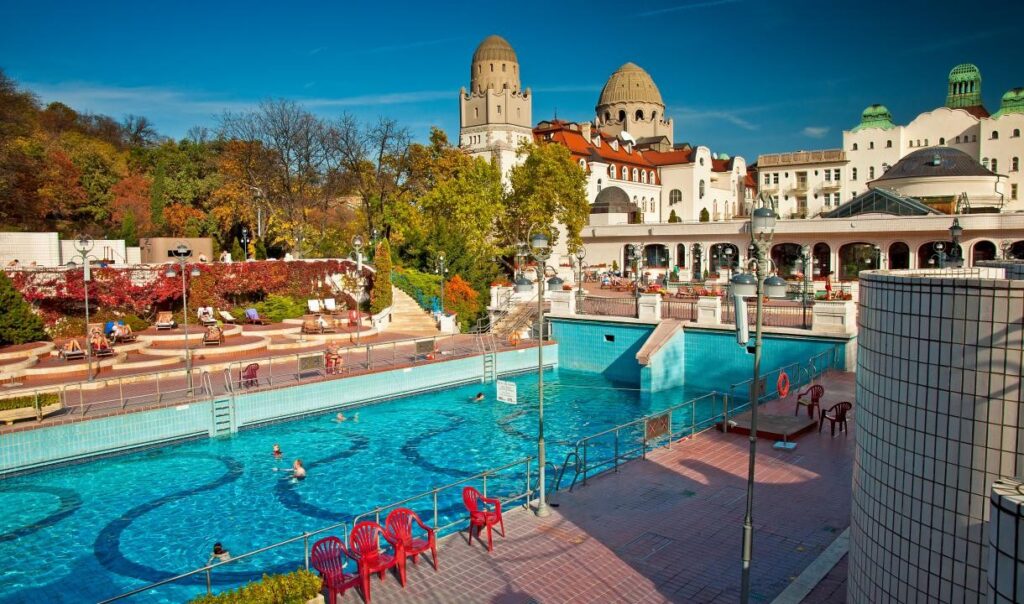
Essential Information
| Category | Details |
|---|---|
| Location | Kelenhegyi út 4, 1118 Budapest, Hungary – at the foot of Gellért Hill on the Buda side. |
| Website | gellertfurdo.hu (official site) |
| Price Range | Daily ticket with locker: 11 000 Ft weekdays, 12 500 Ft Friday/weekend, 13 500 Ft on public holidays. |
| Opening Hours | 9:00 AM–7:00 PM daily; saunas 10:00 AM–6:00 PM; ticket desks close one hour before closing. |
| Best Time to Visit | Weekday mornings (9 AM–noon) for fewer crowds. Wave pool operates May–Sep. |
| Booking & Tips | Book tickets online or arrive early to avoid long queues. Bring your own towel, flip-flops and swim cap – rentals are limited and expensive. Consider a private cabin for secure changing. |
Review Round‑Up: What Guests Are Saying
“We had the chance to enjoy different thermal baths, steam bath and swimming pool…long waiting queue to get tickets but a great experience at this old renowned spa” – Luisa B., Google review, May 2025 wanderlog.com.
“Beautiful decor inside…the variety of pools and informative temperature details are great, though some find the facilities basic for the price; bring your own swimwear, towels and flip‑flops” – Wanderlog summary of multiple reviewers wanderlog.com.
“When I first walked into the entrance hall I was impressed by its grandeur: beautiful tiled floors, marble columns and potted palms…multiple indoor thermal pools set in stunning buildings with a great range of temperatures” – Travel blogger, 2016 sallyporte.wordpress.com.
“The two thermal baths (one at 36 °C and one at 38 °C) were very relaxing. There are no clear signs or information on how the system works, which was a little frustrating” – Same blogger sallyporte.wordpress.com.
“It has long ceased to be an authentic Hungarian experience and caters almost exclusively for tourists who are willing to pay a greater entrance fee than other baths” – Travel blogger’s candid verdict sallyporte.wordpress.com.
“Nice indoor areas and architecture; go early to avoid crowds. Bring slippers and a towel. Gellért may close for renovations soon” – Reddit commenter old.reddit.com.
“Visited Gellért, Rudas and Széchenyi; Gellért was our favourite: it wasn’t crowded and the staff were polite – we returned on our last day” – Another Reddit user reflecting on 2023 trip old.reddit.com.
“The indoor spa baths were the real draw. All the rooms have mosaics and different patterns…Gellért felt more luxurious and less chaotic than Széchenyi” – Orcadian Abroad comparison blog anorcadianabroad.com.
“Gellért’s outdoor area is quite small compared to Széchenyi – just one small bath and a swimming pool” – Same comparison blog anorcadianabroad.com.
The consensus? Travellers fall in love with Gellért’s Art Nouveau setting and varied thermal pools.
Many emphasise the need to bring your own towel, flip‑flops and swim cap, and to arrive early to avoid the queues and enjoy the calmer atmosphere.
A few note that signage is confusing and that the bath feels more tourist‑oriented and expensive than some of Budapest’s other options.
Those seeking rowdy outdoor scenes may prefer Széchenyi, but design lovers consistently rate Gellért higher.
Frequently Asked Questions
| Question | Answer |
|---|---|
| Are Gellért Baths mixed or single-sex? | Pools are generally co-ed. The bath has not held gender-segregated days since 2013. |
| Do I need a swim cap? | A cap is mandatory in the main 27 °C swimming pool. It is not required in thermal pools. |
| What should I bring? | Bring swimwear, flip-flops, a towel and swim cap. Rentals are limited and costly. |
| Are children allowed? | Children under 14 may only use the thermal pools with a doctor’s prescription. The wave pool and swimming pool are open to families. |
| How long should I stay? | Most visitors spend 2–4 hours. Reddit commenters suggest that 2–3 hours is enough due to the tiring nature of thermal bathing. |
| When is the wave pool open? | The outdoor wave pool operates from 1 May to 30 September, weather permitting. |
| Is Gellért undergoing renovation? | Parts of the hotel complex have been under renovation, but the baths remain open. Locals suggest checking the official website for updates. |
| How do I avoid crowds? | Visit on weekday mornings. Arriving before 10 AM helps secure lockers and enjoy the baths before tour groups arrive. |

